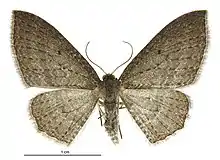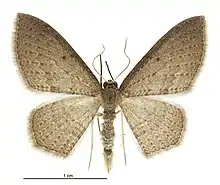Poecilasthena subpurpureata
Poecilasthena subpurpureata is a species of moth of the family Geometridae. It was first described by Francis Walker in 1863 and it is endemic to New Zealand.[2] A synomic species, Astheniodes polycymaria (the two species have almost identical male genitalia),[3] has a holotype that was recorded by George Hampson as being from India, which, as Dayong Xue and Malcolm J. Scoble point out in their paper, would be a very strange distribution pattern.[3] Louis Beethoven Prout reasonably calls this an error in his 1926 paper.[4]
| Poecilasthena subpurpureata | |
|---|---|
 | |
| Female | |
 | |
| Male | |
| Scientific classification | |
| Kingdom: | |
| Phylum: | |
| Class: | |
| Order: | |
| Family: | |
| Genus: | |
| Species: | P. subpurpureata |
| Binomial name | |
| Poecilasthena subpurpureata | |
| Synonyms | |
| |
References
| Wikimedia Commons has media related to Poecilasthena subpurpureata. |
- Yu, Dicky Sick Ki. "Poecilasthena subpurpureata (Walker 1863)". Home of Ichneumonoidea. Taxapad. Archived from the original on 7 November 2017. Retrieved 31 October 2017.
- "Poecilasthena subpurpureata (Walker, 1863)". New Zealand Organisms Register. Landcare Research New Zealand Ltd. Retrieved 31 October 2017.
- Xue, Dayong; Scoble, Malcolm J. (June 27, 2002). "A review of the genera associated with the tribe Asthenini (Lepidoptera: Geometridae: Larentiinae)". Bulletin of the Natural History Museum. Entomology Series. 71 (1): 77–133. doi:10.1017/S0968045402000044.
- Prout, Louis B. (11 December 1926). "Notes on New Zealand Geometridae" (PDF). Nelson Philosophical Society – via National Library of New Zealand.
This article is issued from Wikipedia. The text is licensed under Creative Commons - Attribution - Sharealike. Additional terms may apply for the media files.